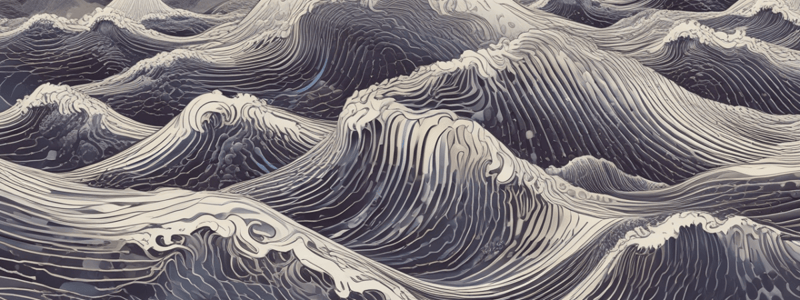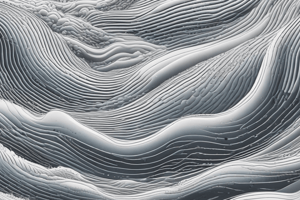Podcast
Questions and Answers
What type of waves are P waves?
What type of waves are P waves?
- Rayleigh waves
- Surface waves
- Transverse waves
- Longitudinal waves (correct)
What can be concluded about the Earth's outer core based on the study of P and S waves?
What can be concluded about the Earth's outer core based on the study of P and S waves?
- It is a solid
- It is a mixture of solid and liquid
- It is a liquid (correct)
- It is a gas
What characteristic do Rayleigh waves have?
What characteristic do Rayleigh waves have?
- They have only horizontal components
- They have both vertical and horizontal components (correct)
- They are only transverse
- They are only longitudinal
What type of wave is an ocean wave that travels along the surface of water?
What type of wave is an ocean wave that travels along the surface of water?
What is the motion of particles in a Rayleigh wave?
What is the motion of particles in a Rayleigh wave?
What type of wave can pass through a liquid?
What type of wave can pass through a liquid?
What is the characteristic of the motion of particles in an ocean wave?
What is the characteristic of the motion of particles in an ocean wave?
What can be said about S waves?
What can be said about S waves?
What direction do particles move in a transverse wave compared to the direction of the wave?
What direction do particles move in a transverse wave compared to the direction of the wave?
What is the highest point of a transverse wave called?
What is the highest point of a transverse wave called?
What term describes the distance between two consecutive crests in a transverse wave?
What term describes the distance between two consecutive crests in a transverse wave?
What type of wave requires a medium to travel through?
What type of wave requires a medium to travel through?
Which of the following is NOT an example of a transverse wave?
Which of the following is NOT an example of a transverse wave?
What visual representation is typically used to describe a transverse wave?
What visual representation is typically used to describe a transverse wave?
What type of wave does not require a medium to transmit energy?
What type of wave does not require a medium to transmit energy?
Which of the following correctly describes the movement of particles in a longitudinal wave?
Which of the following correctly describes the movement of particles in a longitudinal wave?
Which type of wave can travel through both solids and fluids?
Which type of wave can travel through both solids and fluids?
What phenomenon is responsible for the creation of areas of high pressure in a longitudinal wave?
What phenomenon is responsible for the creation of areas of high pressure in a longitudinal wave?
Which electromagnetic wave from the options below is primarily responsible for energy from the Sun?
Which electromagnetic wave from the options below is primarily responsible for energy from the Sun?
What determines the wavelength of a longitudinal wave?
What determines the wavelength of a longitudinal wave?
Flashcards are hidden until you start studying
Study Notes
Definition of Transverse Wave
- Transverse waves feature particle motion at right angles to the direction of wave propagation.
- Visual representation resembles a sine or cosine curve, with distinct characteristics like crests and troughs.
Key Characteristics
- Crest: The highest point of a wave, represented by +1 on the y-axis.
- Trough: The lowest point of a wave, represented by -1 on the y-axis.
- Wavelength: Distance between two consecutive crests or troughs, defining one complete wave cycle.
Examples of Transverse Waves
- Generated by moving one end of a string up and down or side to side.
- Observed in guitar string vibrations and ripples on water surfaces.
Types of Transverse Waves
- Mechanical Waves: Require a medium to travel; consist of interconnected particles.
- Electromagnetic Waves: Do not need a medium; can transmit through a vacuum; produced by vibrating charged particles, creating electric and magnetic fields.
- Common forms include sunlight, radio waves, microwaves, and X-rays.
Comparison with Longitudinal Waves
- Longitudinal waves feature particle movement parallel to wave direction, arising from particle compression.
- Sound is a primary example; vocal cords create vibrations that push air particles, leading to compressions and rarefactions.
Diagrammatic Representation
- Transverse waves show vertical particle motion, while longitudinal waves indicate parallel vibrations relative to energy transfer.
Medium Compatibility
- Transverse waves can only travel through solids due to the need for closely packed particles.
- Longitudinal waves can traverse solids, liquids, and gases, as particles in these states are able to slide past each other.
Earthquake Waves and Internal Structure
- Earthquakes generate both P waves (longitudinal) and S waves (transverse).
- S waves cannot pass through the Earth’s outer core, indicating it is liquid, while P waves can, signifying their ability to travel through various states of matter.
Surface Waves
- Rayleigh Waves: A combination of transverse and longitudinal characteristics, these waves have both vertical and horizontal components.
- Water waves exhibit circular motion, making them both longitudinal and transverse.
Studying That Suits You
Use AI to generate personalized quizzes and flashcards to suit your learning preferences.




